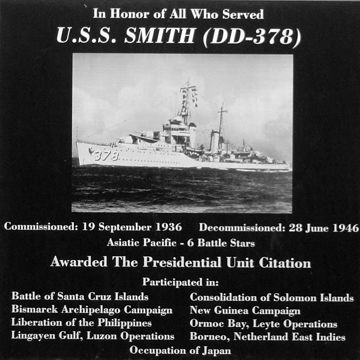

Smith at the Battle of the Santa Cruz Islands.
Smith went to the south Pacific in October 1942 to join in the fight to hold Guadalcanal. While screening Enterprise with battleship South Dakota, heavy cruiser Portland, anti-aircraft cruiser San Juan and destroyers Porter (DesRon 5 flagship), Mahan, Conyngham, Shaw, Cushing, Preston and Maury during the Battle of the Santa Cruz Islands, she was hit by a Japanese torpedo bomber that deliberately crashed into her forward superstructure. Despite extensive damage and the loss of nearly sixty crewmen, Smith was able to extinguish her fires, in part by dousing them in South Dakota’s wake, and continued to defend her task force—for which she was awarded the Presidential Unit Citation.
Following repairs, Smith returned to the South Pacific through May 1943. In June, she joined the Seventh Fleet for operations along the New Guinea’s north coast—including bombardments at Finschhafen and Lae, landings at Arawe and Cape Gloucester, New Britain, and in the Admiralty Islands into February 1944. She was present when Henley was lost on 3 October.
From July 1944, after a West Coast overhaul, Smith conducted training, patrol and escort work in the central Pacific before rejoining the Seventh Fleet in late October for the Leyte landings. In December, during the Ormoc Bay landings on Leyte’s west coast, she was attacked by Japanese suicide planes (see Mahan) but escaped damage.

Memorial Wall plaque
National Museum of the Pacific War,
Fredericksburg, Texas.
In January 1945, Smith took part in the Lingayen Gulf invasion. From then until mid-August, she was active in the Philippines and Borneo, escorting convoys, and providing gunfire support for landings at Palawan, Cebu, Tarakan Island and Balikpapan, where on 1 July 1945, she was slightly damaged by Japanese artillery, which she then silenced.
Following the end of the Pacific Warw Smith transported Allied prisoners of war from Japan to Okinawa, then sailed to California, where she arrived in mid-November. Returning to Pearl Harbor late in the year, she remained there until decommissioned in late June 1946. She was stricken from the Navy list in February 1947 and sold for scrap that August.
In addition to her Presidential Unit Citation, Smith earned six battle stars for her service in World War II.